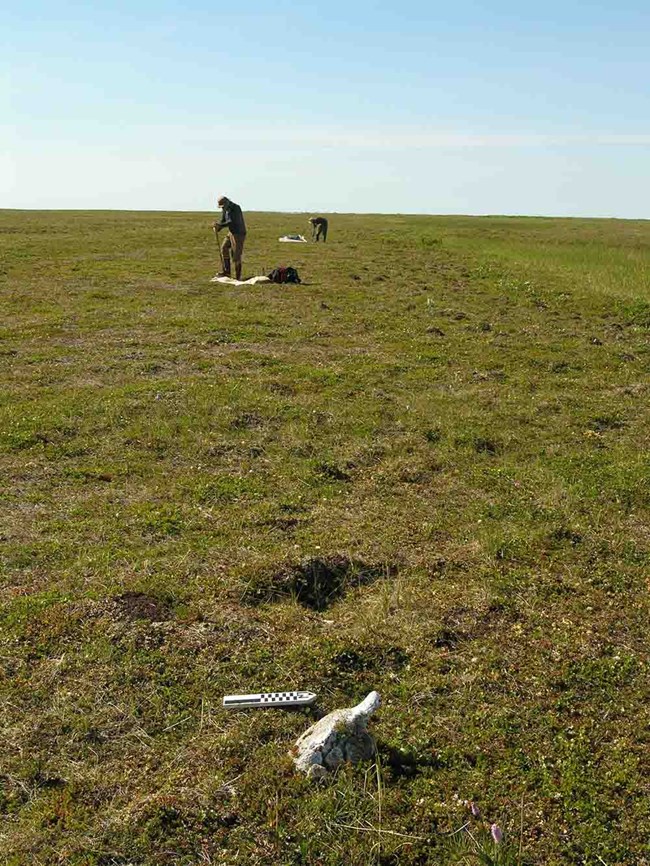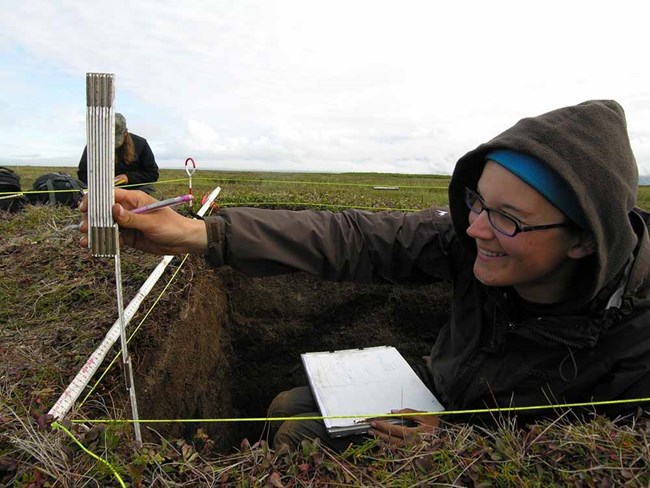Last updated: January 27, 2021
Article
How the Arctic coast and culture intertwined

NPS/Adam Freeburg
The Arctic is a challenging place to live. These challenges can be exacerbated by environmental variability that affects the abundance of already-limited food resources. Throughout the mid- to late Holocene, people in northwest Alaska not only faced varying environmental conditions, but also changing social and political conditions. Research funded by the National Park Service and carried out with the University of Washington and Antioch University New England studied the relationship between cultural and environmental changes by refining and comparing paleoenvironmental and archaeological chronologies.
At Cape Krusenstern National Monument, on the north shore of Kotzebue sound, previous research established a framework for studying changes in the coastal beach ridge complex and the people who lived there since soon after its initial formation around 5,000 years ago. Beach ridges are formed from sediments transported by wave action onto land. Over time, beach ridges are added on the seaward side of the coast. Changes in prevailing wind and wave action can alter the orientation of the ridges relative to the existing coast. Periodically, erosion removes portions of the ridges. Throughout all these changes, people lived for various portions of the year on these continually changing ridges.
Systematic archaeological testing and geomorphological mapping and sampling resulted in the collection of dateable organic materials such as charcoal, bone, and antler left behind by people as well as driftwood and peat from natural processes. By dating these samples, researchers built distinct, but comparable, chronologies that could help answer questions about the timing and relationship between environmental conditions and changes in culture, such as settlement or subsistence patterns. Both the new archaeological and geomorphological chronologies support previously established models of local coastal landscape evolution and cultural change.

NPS/Adam Freeburg
The increase in dated sample size and the higher resolution of the resulting chronologies yielded important insight and nuance to this model. It is now clear that many, if not all, of the beach ridges are composites formed over various time scales ranging from years to decades. Internal stratigraphy of beaches shows fluctuations in wave energy through stacked deposits of varying grain size. Depositional events such as large storms can throw sediments inland over older, landward ridges. Ridges can also bifurcate and coalesce depending on the wave direction, energy, or sediment supply. Consequently, individual beach ridges are not as precise indicators of time they are sometimes thought of.
The new data do support the existing model of relative stability of coastal processes from approximately 5,000-3,000 years ago. This period coincides with initial occupation of the beach ridges and development of Arctic maritime cultural adaptations in northwest Alaska. Despite a shift in environmental conditions between approximately 2,100 and 1,000 years ago, local settlement increased, with people likely living on the coast for longer periods and in denser groups. Another change in environmental conditions around 1,000 years ago coincides with an interpreted decline in population at local and regional scales that is followed by a rapid population increase until around 500 years ago.
Human settlement and Mid-Late Holocene coastal environmental change at Cape Krusenstern, Northwest Alaska
Abstract
Archaeologists hypothesize that mid-late Holocene environmental variability played a role in several significant western Arctic cultural developments including population fluctuations, the evolution of Arctic maritime adaptations, and Arctic-wide migrations. Further evaluation of these hypotheses requires higher resolution archaeological and paleoecological datasets than are currently available. In response, we undertook an interdisciplinary study at Cape Krusenstern, a large coastal site complex in northwest Alaska, which was occupied over the last ca. 5000–6000 years. Our goals were to refine local cultural and paleoenvironmental chronologies and to explore the question of how local environmental change may have influenced local settlement history. The resulting revised chronology and depositional units confirm and refine prior interpretation of the local archaeological settlement history. New geomorphological data on coastal environmental change and post-depositional modification of the Cape Krusenstern beach ridge system also provide information about patterns of archaeological site preservation, indicating periods of potentially poorer site preservation around 3990 cal BP; this informs interpretation of forager settlement data. Furthermore, our findings suggest that climate-driven changes in the coastal environment at Cape Krusenstern may not be as determinative in terms of landscape evolution as previously thought. Future work should focus on further investigating the relationship between beach ridge development and regional climatic patterns on a regional scale, as this has implications for use of beach ridges as a mid-late Holocene climate proxy. Continued efforts to build paleoenvironmental reconstructions of higher temporal and spatial resolution for the region will help address remaining questions about the relationship between local coastal environmental changes and regional patterns, and the impacts of these environmental shifts on local residents.
Anderson, S., J. Jordan, and A. Freeburg. 2020. Human settlement and Mid-Late Holocene coastal environmental change at Cape Krusenstern, Northwest Alaska. Quaternary International 549: 84-97.
